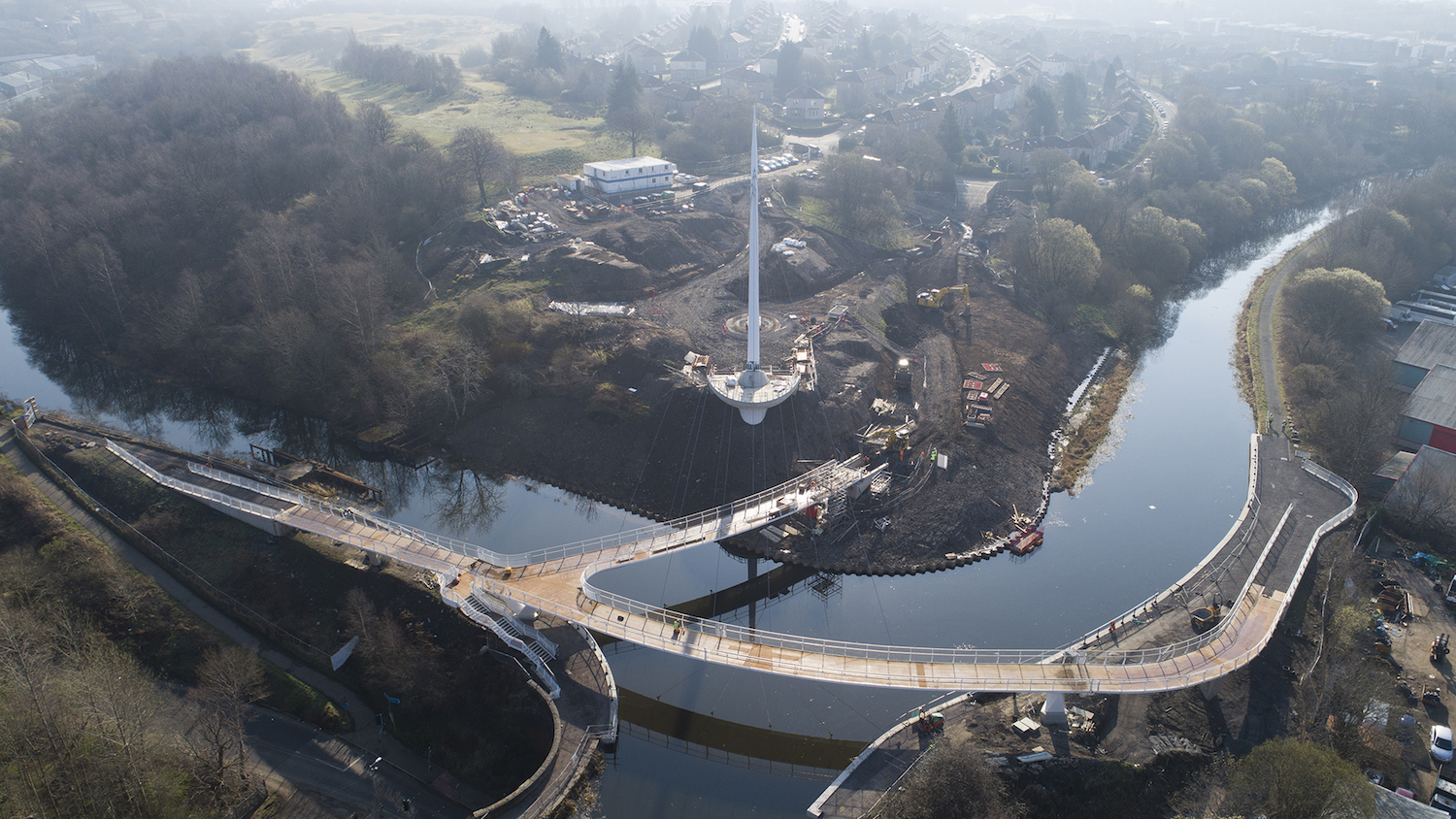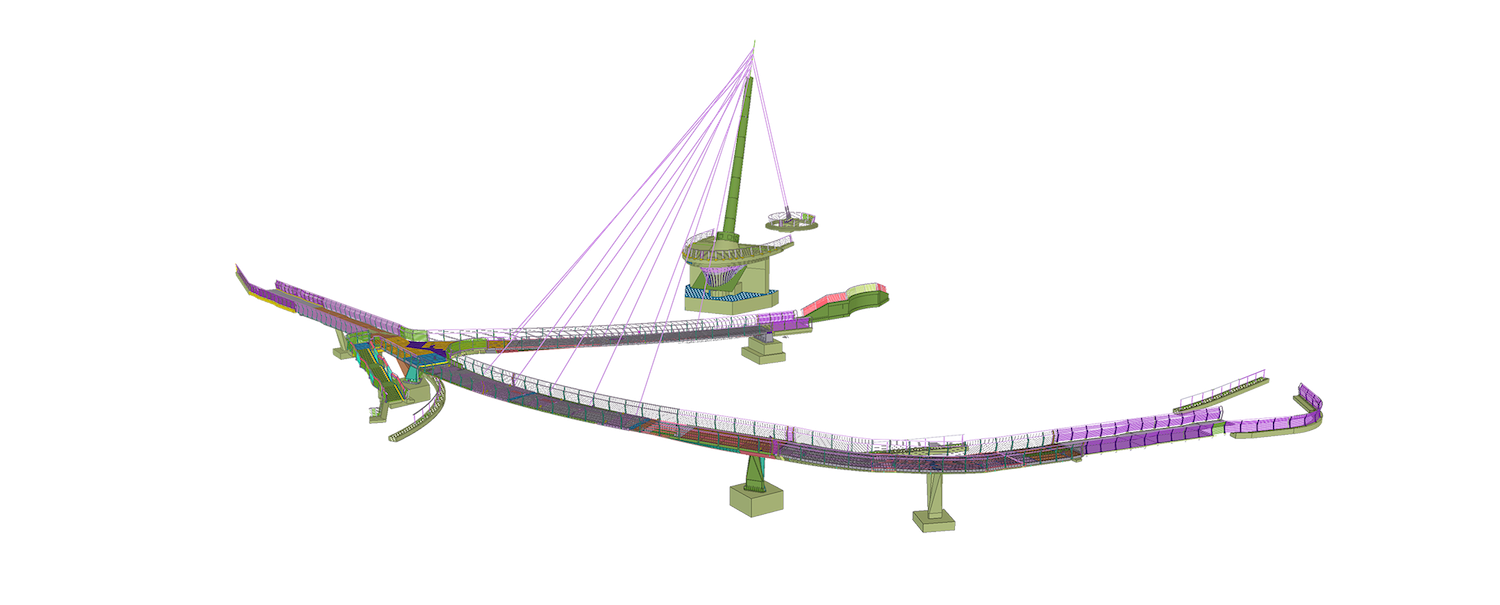
Steel specialist SH Structures faced many challenges when modelling, fabricating, supplying and assembling key parts of a footbridge in north-west Glasgow for Scottish Canals and Balfour Beatty.
Located in the Maryhill area of Glasgow, the new Stockingfield Footbridge is a twin-span cable stay structure designed to provide access across the Stockingfield Junction on the Forth & Clyde Canal. Jacobs designed the bridge, while Balfour Beatty has delivered it for client Scottish Canals.
As well as reconnecting three communities (Ruchill, Gilshochill and Maryhill), it will provide the last linkage in the canal towpath. In addition to the two curved bridge decks, the structure features a viewing platform (taking advantage of the site’s elevated view) below a focal 34m-high inclined tapered mast.
SH Structures was responsible for modelling, fabricating, supplying and assembling the mast, twin decks, access ramps and stairs/balustrade system that formed the completed bridge structure. The specialist used a combination of Trimble’s constructible modelling software and hardware to deliver the works.
Complex site challenges
Martin Selby, senior CAD technician at SH Structures, says: “The Stockingfield Footbridge project was particularly special to us for many reasons. It was a chance for us to work with Scottish Canals, with whom we’ve developed an excellent relationship. Also, bridges are always unique, especially those that have been carefully considered and designed to create a legacy for the communities who use them.
“Complex projects inevitably present a wide range of challenges and bridges of this scale are no exception. Perhaps our main challenge on this job was to develop a design that would give the required connection across the canal junction. In particular, it was a challenge getting something to work structurally that would cope with the complex dynamics and site topography, while also fitting into the congested site.
“Maintaining the required clearance under the bridge and the required slope of the ramps, while simultaneously tying into the alignment of the towpaths, was also a major headache at the initial stages.
“All of this resulted in a complex geometry where most of the deck section soffits were twisted plates. Curving steel in one direction is a relatively simple process. Curving it in two directions, like we had to do here, was definitely more of a challenge. It’s these areas of complexity where the 3D visualisation offered within Tekla is so valuable. It enabled us to offer our client a fully rendered model, containing all of the materials – a model that can then form a central part of discussions.”

Embracing technology
As well as the Tekla Structures 3D detailing software, SH Structures also used the Trimble SX10 – a scanning total station that combines surveying, imaging and high-speed 3D scanning in one instrument – coupled with a TSC7 controller.
Selby explains: “Thanks to the software integration, we were able to export the completed Tekla model as an IFC file. We imported this directly into the SX10. This gave the engineering and site team full access to the accurate model data and 3D coordinates at any given point on the bridge structure. This proved vital when setting out on site.
“Not only were we able to check that the dimensions and geometry were correct as assembly progressed, we were also able to verify the movements of the deck profile and mast as the cables were being tensioned.
“Due to the size and complexity of the bridge, there were various sub-assemblies constructed using temporary works on a designated part of site. With three bridge sections (all of which had to come together at one central point before being welded into place) and the foundations and bearing points already having been installed by the contractor, everything had to align perfectly. We were working to some extremely tight tolerances. Here, setting out using the SX10 and 3D model coordinates helped to ensure all went ahead smoothly on site.”
Pushing data further
SH Structures pushed the data flow between Trimble’s BIM software and its site hardware further. Having imported the IFC file into the SX10 device and using the SX10 camera, the team were able to view a live overlay of the model in the context of the real-time site.
“This capability proved extremely helpful, ideal for checking and verifying that everything was lining up and in the right position. It really provided us with additional peace of mind,” says Robert Binks, project manager at SH Structures. “Being able to flip between live images and the 3D model gave a nice, visual representation of what you were currently seeing on site compared to the end-goal.”
SH Structures’ work on the Stockingfield Footbridge project helped the steel fabricator to win the Infrastructure Project category in the 2022 Tekla Awards. The judges praised the project as a great example of how to execute a Trimble model to field.
Don’t miss out on BIM and digital construction news: sign up to receive the BIMplus newsletter.











